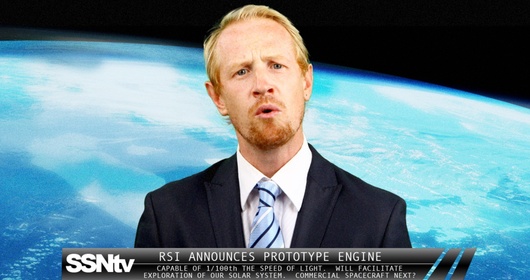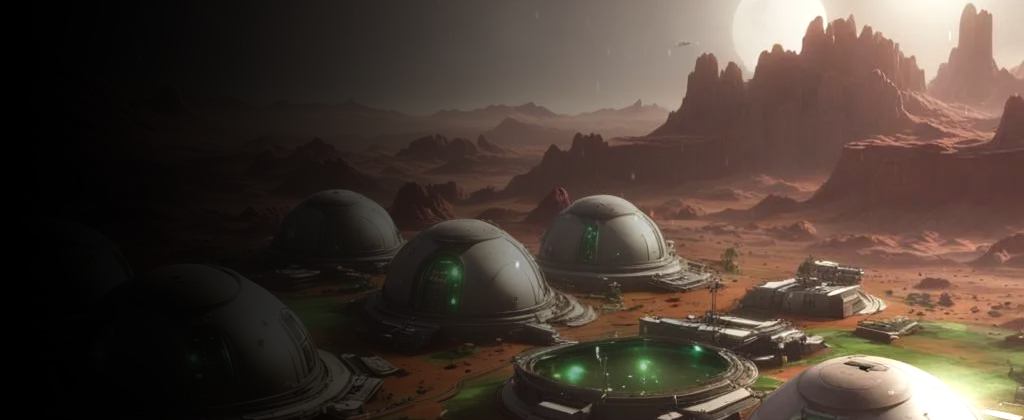:: COSMIC CRONICLES ::
The Cosmic Chronicles are ‘Special Episodes’ crafted to enhance the content on this page. I have put effort to present the rich Star Citizen Lore in an easily digestible manner for those who may lack time or prefer not to read extensive texts. Our First episode delves into the Content covered on this Page – the early years, spanning from 2075 to the turn of the century in 2200. You can listen to it on Spotify.

The Genesis of Quantum Travel (2075)
The inception of this epoch was heralded by Dr. Scott Childress and his team, who, in 2075, successfully developed the first self‐sustaining quantum drive engine capable of achieving 1/100th the speed of light.
This monumental achievement not only redefined propulsion technology but also symbolized humanity’s untethering from the confines of our solar system. The quantum drive’s ability to shorten interstellar distances opened up new vistas for exploration, placing the galaxy within our grasp and marking the beginning of an era of unparalleled discovery.
Pathways to New Worlds
The year 2113 marked an extraordinary leap in mankind’s profound journey across the stars. On April 21st, Roberts Space Industries, known throughout the cosmos for their unrelenting pursuit of the stars, patented a groundbreaking technology that promised to transform lifeless orbs into cradles of human civilization.
RSI technological achievement was not only an impressive display of human ingenuity but also a gateway to boundless opportunities across the galaxy. Their process, which pioneered the conversion of a planet’s atmosphere into a sustainable oxygen environment, made the dream of terraforming a startling reality.
However, this engineering marvel did not come without its drawbacks. Hannigan Terrell postulates in his article ‘When Do We Go Too Far?’ that transforming planets raises profound ethical questions. As interlopers in this universe, are we entitled to sculpt celestial bodies to our will? Terrell’s skepticism challenges us to ponder the far‐reaching consequences of our technological ambition.
With the barriers to distant travel effectively dismantled, humanity embarked on the establishment of its first off‐world colonies. The Moon and Mars served as the stepping stones for these early endeavors.

The Red Planet
In 2120, nations of Earth collaborated to undertake an unprecedented venture in human history: the terraforming of Mars. This planetary conversion marks a significant milestone in space exploration. Teams of surveyors were tasked with generating topographical maps, placing atmospheric processors, and testing for contaminants on the Red Planet. Port Renatus was established as the landing point and basecamp for this mission to claim a new world as humanity’s second home.
These individuals were working tirelessly towards the final stages of a planet‐wide transformation. In 2125, at 04:38 EST, a catastrophic event – now known as the Mars Tragedy – resulted in the loss of 4,876 lives. The researchers believed that the atmosphere was finally stable enough to support life. However, it betrayed the terraformers and dissolved in a chemical cataclysm due to a grievous miscalculation in the atmospheric processors. The workers did not wear any safety apparatus, believing that they had succeeded. As a result, they faced the merciless volatility of the artificial environment they sought to master. This event was a significant setback in our celestial aspirations.
The event was a tragedy that caused deep reflection on the ethics of terraforming. Amid calls for an inquiry and debates over the path forward, those at home and in political spheres cautiously considered the next steps in Terra’s celestial legacy. In the history of Star Citizen, the Mars Tragedy serves as a reminder of humanity’s spirit and lessons learned in the pursuit of the unknown. We explore the stars thanks to the efforts of pioneers, always mindful of the sacrifices made on distant worlds to expand the horizons of humanity.
Many years after this tragedy, humankind continues to develop further technologies. The first commercially available spaceship, the ZEUS by RSI, was presented.
On 18th March 2157, after almost forty years of research and development, and at a great cost to human life, Mars was officially declared an oxygen‐sustaining environment, successfully terraformed at last. This achievement is a testament to humanity’s indomitable spirit. The ceremony marked a significant achievement and paid tribute to those who lost their lives in the Great Mars Tragedy of 2125. The unveiling of a memorial dedicated to the victims provided a solemn backdrop for the event. Senator Stephen Nguyen delivered a keynote speech that resonated with personal loss and served as a poignant reminder of the human element behind scientific endeavors.
The memorial inscribes the names of the fallen and stands as a chronicle of sacrifice. It is a testament to the souls lost in pursuit of a dream bigger than any one life. Senator Nguyen’s words captured the essence of this paradox objectively. He drew from his own narrative of loss, with his brother Sean counted among those lost in the tragedy, and brought a heartrendingly intimate perspective to the gathering.
Life Sustained Amongst the Stars
Humanity’s expansion into space required advances in life support and habitat technology. Innovations in closed ecosystems, modular habitat construction and artificial gravity paved the way for sustainable life in space. These advances were critical to ensuring that humanity could not only survive but thrive in the depths of space, and laid the groundwork for the development of advanced space stations and larger interstellar vessels.
The dawn of quantum travel brought about a profound transformation in societal and cultural norms. As humanity spread across the solar system, a collective identity began to form, transcending Earthly divisions. This period fostered a sense of unity and shared purpose, as individuals from diverse backgrounds worked together to navigate the challenges and opportunities of life among the stars.
Emboldened by the successes of quantum travel and the burgeoning space economy, humanity began to cast its gaze further afield, laying the conceptual and technological groundwork for journeys beyond our solar system. The dream of interstellar travel began to morph from fiction to tangible goal, igniting the imaginations and ambitions of a species now poised on the brink of the unknown.
Legacy of the Dawn
The era from 2075 to 2200, „The Dawn of Quantum Travel”, is a testament to human ingenuity, ambition and the irrepressible drive to explore. It set in motion the events that would define the Star Citizen universe, a narrative weaving rich with adventure, conflict and the relentless spirit of exploration. This epoch not only reshaped humanity’s trajectory among the stars, but also established the foundational lore upon which players and enthusiasts continue to build.
